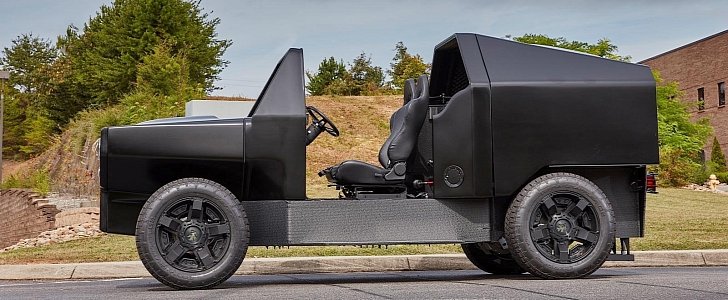You probably remember how we were all supposed to dress in silver overalls and drive weird-looking cars with glass cupolas by the year 2000, but that luckily didn't happen.
Still, that image of the future suddenly became very appealing when compared to this proposal from U.S. Department of Energy's Oak Ridge Laboratory.
It's called AMIE and it can best be described as a symbiotic system between a stripped-down car and a shotgun house. The Oak Ridge Laboratory is taking full advantage of the world's largest 3D printer they happen to own, using it to build this admittedly smallish house and a pretty exposed Jeep Willys lookalike.
As you might have imagined, electricity plays a key role in this whole AMIE project, which, by the way, stands for Additive Manufacturing Integrated Energy. The first two words refer to the manufacturing process that relies on the use of carbon fiber-reinforced ABS plastic composite material. It makes up for almost 80 percent of the house and about 30 percent of the car, which is then topped off with close to two tons of technology. If the time taken to "print" the 210-square foot house is a staggering four weeks, the car apparently only needed about 20 hours to be completed.
The latter two words that make up the AMIE acronym hint at a microgrid with two batteries that connect the house and the car. The first battery sits under the house's porch and gets charged up via solar pannels. The car, on the other hand, uses an onboard natural gas generator to provide juice for its own battery, good for that 35 miles (50 km) maximum range.
And now comes the symbiotic part. Whenever the car parks next to the house, they exchange electric power one way or the other through "the world’s first Level 2 (6.6kW) [wireless power] bi-directional system." In other words, the car can charge its batteries with solar power while on a cloudy day, the house can use the car's engine as a generator.
In the future, the Lego-like Willys can get resort to other types of fuel to generate electricity, from stuff like biofuels to even hydrogen-powered fuel cells, BBC reports.
The house too is a modular affair, each "slice" having all the amenities it needs from the good old windows to solar panels, very efficient thermal insulation, integrated electrical network and interior finishes. The number of elements that can be combined is virtually infinite, but the concept was kept within the limits of a standard mobile home chassis.
This whole project is a cooperation between very important entities in various fields like architecture or technology and is meant to provide people with an idea about what a future sustainable house could look like. If you don't like what you see, then maybe it's time you changed your living habits so that this future won't yet be necessary for a while.
It's called AMIE and it can best be described as a symbiotic system between a stripped-down car and a shotgun house. The Oak Ridge Laboratory is taking full advantage of the world's largest 3D printer they happen to own, using it to build this admittedly smallish house and a pretty exposed Jeep Willys lookalike.
As you might have imagined, electricity plays a key role in this whole AMIE project, which, by the way, stands for Additive Manufacturing Integrated Energy. The first two words refer to the manufacturing process that relies on the use of carbon fiber-reinforced ABS plastic composite material. It makes up for almost 80 percent of the house and about 30 percent of the car, which is then topped off with close to two tons of technology. If the time taken to "print" the 210-square foot house is a staggering four weeks, the car apparently only needed about 20 hours to be completed.
The latter two words that make up the AMIE acronym hint at a microgrid with two batteries that connect the house and the car. The first battery sits under the house's porch and gets charged up via solar pannels. The car, on the other hand, uses an onboard natural gas generator to provide juice for its own battery, good for that 35 miles (50 km) maximum range.
And now comes the symbiotic part. Whenever the car parks next to the house, they exchange electric power one way or the other through "the world’s first Level 2 (6.6kW) [wireless power] bi-directional system." In other words, the car can charge its batteries with solar power while on a cloudy day, the house can use the car's engine as a generator.
In the future, the Lego-like Willys can get resort to other types of fuel to generate electricity, from stuff like biofuels to even hydrogen-powered fuel cells, BBC reports.
The house too is a modular affair, each "slice" having all the amenities it needs from the good old windows to solar panels, very efficient thermal insulation, integrated electrical network and interior finishes. The number of elements that can be combined is virtually infinite, but the concept was kept within the limits of a standard mobile home chassis.
This whole project is a cooperation between very important entities in various fields like architecture or technology and is meant to provide people with an idea about what a future sustainable house could look like. If you don't like what you see, then maybe it's time you changed your living habits so that this future won't yet be necessary for a while.

